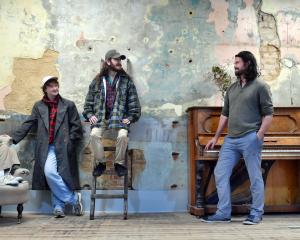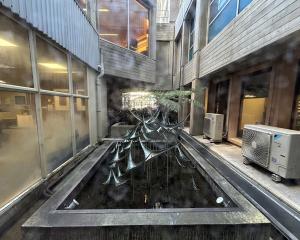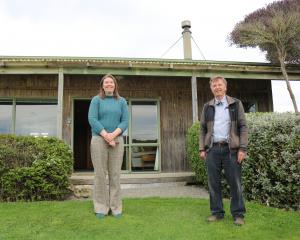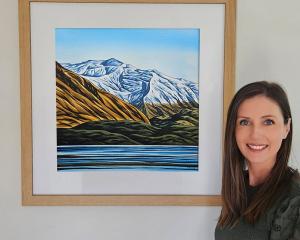The Dunedin Public Art Gallery is hosting "Journeywork'', a major retrospective of New Zealand sculptor Peter Nicholls.
This is no mean feat, as Nicholls' art, by and large, is as colossal in size as it is impressive and imposing in form.
Nicholls is probably best known locally for two large public works: Toroa which sits close to the Dunedin wharves, and Bridge, at the university's campus. Both pieces are distinctive for their heavy wooden beams, from which the artist has constructed seemingly delicate forms.
Nicholls has been drawn to the landscape, particularly to rivers, for his inspiration. His hewn timber constructions are frequently inlaid with heavily patinated metal, or with the tools of the worker of the land.
In works like Cut and River Crossings, these inlays form highways or rivers through the plains and undulating hills of wood.
Many of the pieces displayed are accompanied by initial sketches and designs, which gives further insight into the artist's thoughts and methods of construction.
In this way the artist expresses the symbiosis of the landscape and those who work on and in it, the balance and inter-connectedness of land and worker.
His art also expresses the river-like journey of a person's life and - by extension - this exhibition chronicles Nicholls' own journey.
Perhaps the single most startling work in this exhibition is the one at furthest remove from Nicholls' timber edifices.
In Musa, the artist has taken two worn mantles from old ore-crushing machinery and created from them an altar-like sculpture. The resulting piece is delicately balanced and remarkable in its serenity.
Serenity is also a feature of the surprising edifices occupying the Temple Gallery in "Evergreen''.
Whereas Nicholls works in timber and metal, Anna Muirhead's colossal art is of more surprising materials, such as corrugated cardboard. From these, the artist has created a tranquil, zen-like stage-set garden.
Massive gates and pillars surround a central courtyard featuring a linoleum gazebo and a waterfall of broken crockery.
The artist's stated intention is to compare and contrast the attempts of the landscape gardener to control and mimic the natural world with the everyday nature of her commonplace construction materials.
Though unstated, it is hard not to also read into this exhibition some commentary on the Chinese Garden under construction in Dunedin - especially as the central courtyard, with its formal columns and pagoda-like gazebo, is dominated by its cascade of china.
Whether this was the artist's intention or not, the work stands on its own merit as an impressive peaceful sanctuary created with the most unlikely of media, a temple within the Temple.
It is difficult to give a quick overview of "Relationships'' at the Community Gallery, as the work presented is so wildly diverse.
Fifteen artists are involved, with styles and form ranging from Jacque Ruston's "bead tree'' constructions through the landscape paintings of Graham Geary and Fiona Sterling to Bruce Hellyer's impressive delicate wooden bowls.
Among the better-known artists with work on display are mother and son Pauline Bellamy and Manu Berry, both of whom present impressive pieces.
Berry's gentle woodcut Inlet Swans gives a rare hint of the influence of the mother's art on that of her son, especially when presented alongside works by Bellamy such as Paquita.
There are numerous other impressive works on display. Kirsten Ferguson's forceful graphite and oil portraits catch the eye with their bold heavily-worked forms, as do Jodie Austin's fine ceramics and Oamaru stone carvings.
Several bright abstract oils by Sarah Rees and paintings by Nyree Ingle and Anne Baldock are also of note, as are some delightfully humorous woodcuts by Jon Chapman.
The Artist's Room current exhibition - "A Touch of Whimsy''- combines the work of four artists, all of whom display a touch of whimsy in their art.
The whimsicality is at its peak with the outright humour of Tony Cribb's cartoon Tin Men, each occupying a single panel and engaged in some humorous activity or situation.
The works are simple to the point of being simplistic, but are carried by the personality with which the artist has imbued his characters.
Close to these sit several caricature-like figurines, the thin, friendly forms being the work of ceramicist Cheryl Oliver.
The largest room of the gallery has been given over to the other two artists in the exhibition, Richard Hansen and Crispin Korschen. Korschen's art, like the ceramics of Cheryl Oliver, relies on thin caricatured forms.
In these paintings, the figures seem isolated from their surroundings, and the wistfulness they seem to display produces a sense of introspective calm in the viewer.
Hansen's work is perhaps the least whimsical of the four artists' art on display, being fairly straightforward landscapes and still lifes. The works are not out of place, however, as the gentle impressionistic distortions of the forms gives them a welcoming charm and friendly warmth.













